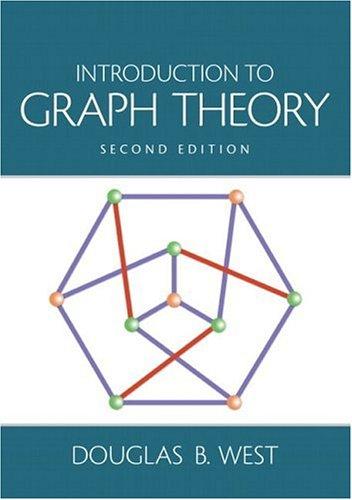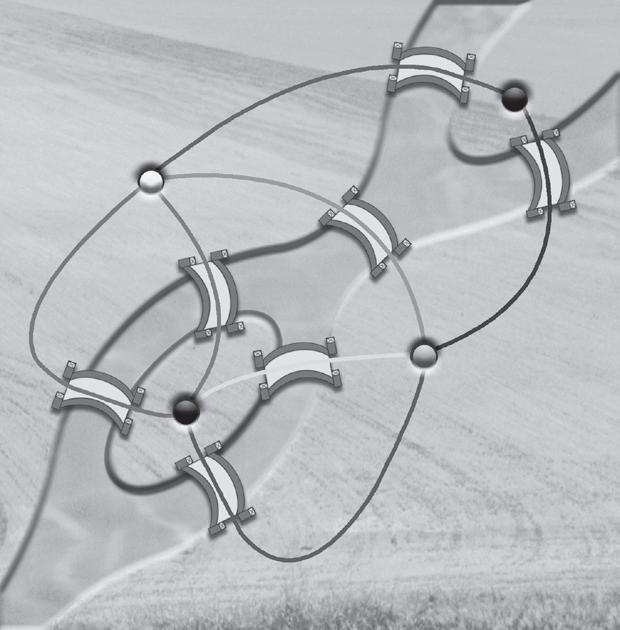2nd Edition Khee Meng Koh
Visit to download the full and correct content document: https://ebookmass.com/product/introduction-to-graph-theory-with-solutions-to-selecte d-problems-2nd-edition-khee-meng-koh/
More products digital (pdf, epub, mobi) instant download maybe you interests ...
Fuzzy Graph Theory: Applications to Global Problems
John N. Mordeson
https://ebookmass.com/product/fuzzy-graph-theory-applications-toglobal-problems-john-n-mordeson/
Introduction to Graph Theory 2, 2002 reprint Edition
Douglas B. West
https://ebookmass.com/product/introduction-to-graphtheory-2-2002-reprint-edition-douglas-b-west/
Data-driven Solutions to Transportation Problems Yinhai
Wang https://ebookmass.com/product/data-driven-solutions-totransportation-problems-yinhai-wang/
Introduction to Quantum Field Theory with Applications to Quantum Gravity 1st Edition Iosif L. Buchbinder
https://ebookmass.com/product/introduction-to-quantum-fieldtheory-with-applications-to-quantum-gravity-1st-edition-iosif-lbuchbinder/
Trigonometry Booster with Problems and Solutions 3e Edition Rejaul
Makshud
https://ebookmass.com/product/trigonometry-booster-with-problemsand-solutions-3e-edition-rejaul-makshud/
International Economics: An Introduction to Theory and Policy 2nd Edition Rajat Acharyya
https://ebookmass.com/product/international-economics-anintroduction-to-theory-and-policy-2nd-edition-rajat-acharyya/
Solutions Manual to Introduction to Robotics Mechanics and Control Third Edition John J. Craig
https://ebookmass.com/product/solutions-manual-to-introductionto-robotics-mechanics-and-control-third-edition-john-j-craig/
Curriculum:
From Theory to Practice 2nd Edition
https://ebookmass.com/product/curriculum-from-theory-topractice-2nd-edition/
Ethical Choices: An Introduction to Moral Philosophy with Cases 2nd Edition Richard Burnor
https://ebookmass.com/product/ethical-choices-an-introduction-tomoral-philosophy-with-cases-2nd-edition-richard-burnor/
Other World Scientific Titles by the Author
Principles and Techniques in Combinatorics
ISBN: 978-981-02-1114-1
ISBN: 978-981-02-1139-4 (pbk)
Chromatic Polynomials and Chromaticity of Graphs
ISBN: 978-981-256-317-0
ISBN: 978-981-256-383-5 (pbk)
Counting
ISBN: 978-981-238-063-0
ISBN: 978-981-238-064-7 (pbk)
Counting: Supplementary Notes and Solutions Manual
ISBN: 978-981-256-915-8 (pbk)
Counting
Second Edition
ISBN: 978-981-4401-90-6
ISBN: 978-981-4401-91-3 (pbk)
Counting: Solutions Manual
Second Edition
ISBN: 978-981-4401-94-4 (pbk)
Introduction to Graph Theory: H3 Mathematics
ISBN: 978-981-270-525-9
ISBN: 978-981-270-386-6 (pbk)
Introduction to Graph Theory: Solutions Manual
ISBN: 978-981-277-175-9 (pbk)
Graph Theory: Undergraduate Mathematics
ISBN: 978-981-4641-58-6
ISBN: 978-981-4641-59-3 (pbk)
Published by
World Scientific Publishing Co. Pte. Ltd.
5 Toh Tuck Link, Singapore 596224
USA office: 27 Warren Street, Suite 401-402, Hackensack, NJ 07601
UK office: 57 Shelton Street, Covent Garden, London WC2H 9HE
Library of Congress Control Number: 2023053687
British Library Cataloguing-in-Publication Data
A catalogue record for this book is available from the British Library.
INTRODUCTION TO GRAPH THEORY With Solutions
to Selected Problems
Copyright © 2024 by World Scientific Publishing Co. Pte. Ltd.
All rights reserved. This book, or parts thereof, may not be reproduced in any form or by any means, electronic or mechanical, including photocopying, recording or any information storage and retrieval system now known or to be invented, without written permission from the publisher.
For photocopying of material in this volume, please pay a copying fee through the Copyright Clearance Center, Inc., 222 Rosewood Drive, Danvers, MA 01923, USA. In this case permission to photocopy is not required from the publisher.
ISBN 978-981-12-8481-6 (hardcover)
ISBN 978-981-12-8501-1 (paperback)
ISBN 978-981-12-8482-3 (ebook for institutions)
ISBN 978-981-12-8483-0 (ebook for individuals)
For any available supplementary material, please visit https://www.worldscientific.com/worldscibooks/10.1142/13637#t=suppl
Desk Editor: Tan Rok Ting
Printed in Singapore
Notation
N = {1, 2, 3, ···}
|S| = thenumberofelementsinthefiniteset S n r = thenumberof r-elementsubsetsofan n-elementset= n! r!(n r)!
B \ A = {x ∈ B|x/ ∈ A},where A and B aresets
i∈I
Si = {x|x ∈ Si forsome i ∈ I},where Si isasetforeach i ∈ I
Inwhatfollows, G and H aremultigraphs,and D isa digraph.
V (G): thevertexsetof G
E(G): theedgesetof G
v(G): thenumberofverticesin G ortheorderof G
e(G): thenumberofedgesin G orthesizeof G
V (D): thevertexsetof D
E(D): thearcsetof D
v(D): thenumberofverticesin D ortheorderof D
e(D): thenumberofarcsin D
x → y : x isadjacentto y,where x,y areverticesin D
x ̸→ y : x isnotadjacentto y,where x,y areverticesin D
G ∼ = H : G isisomorphicto H
A(G): theadjacencymatrixof G
G : thecomplementof G
[A]: thesubgraphof G inducedby A,where A ⊆ V (G)
e(A,B): thenumberofedgesin G havinganendin A andthe otherin B,where A,B ⊆ V (G)
G v : thesubgraphof G obtainedbyremoving v andalledges incidentwith v from G,where v ∈ V (G)
x IntroductiontoGraphTheory
G e : thesubgraphof G obtainedbyremoving e from G,where e ∈ E(G)
G F : thesubgraphof G obtainedbyremovingalledgesin F from G,where F ⊆ E(G)
G A : thesubgraphof G obtainedbyremovingeachvertexin A togetherwiththeedgesincidentwithverticesin A from G,where A ⊆ V (G)
G + xy : thegraphobtainedbyaddinganewedge xy to G,where x,y ∈ V (G)and xy/ ∈ E(G)
N (u)= NG(u): thesetofvertices v suchthat uv ∈ E(G)
N (S)= u∈S N (u),where S ⊆ V (G)
d(v)= dG(v): thedegreeof v in G,where v ∈ V (G)
id(v): theindegreeof v in D,where v ∈ V (D)
od(v): theoutdegreeof v in D,where v ∈ V (D)
d(u,v): thedistancebetween u and v in G,where u,v ∈ V (G)
c(G): thenumberofcomponentsin G
δ(G): theminimumdegreeof G
∆(G): themaximumdegreeof G
χ(G): thechromaticnumberof G
α(G): theindependencenumberof G
G + H : thejoinof G and H
G ∪ H : thedisjointunionof G and H
kG : thedisjointunionof k copiesof G
G(D): theunderlyinggraphof D
nG(H): thenumberofsubgraphsin G whichareisomorphicto H
Cn : thecycleoforder n
Kn : thecompletegraphoforder n
Nn : thenullgraphoremptygraphoforder n
Pn : thepathoforder n
Wn : thewheeloforder n, Wn = Cn 1 + K1
K(p,q): thecompletebipartitegraphwithabipartition(X,Y ) suchthat |X| = p and |Y | = q
3.BipartiteGraphsandTrees71
4.Vertex-colouringsofGraphs97
7.DigraphsandTournaments193
8.Solutionsofselectedquestions225
FundamentalConceptsandBasic Results
1.1TheK¨onigsbergbridgeproblem
InanoldcityofEasternPrussia,named K¨onigsberg,therewasariver, calledRiverPregel,flowingthroughitscentre.Inthe18th century,there weresevenbridgesovertheriverconnectingthetwoislands(B and D)and twooppositebanks(A and C)asshowninFigure1.1. A
Itwassaidthatthepeopleinthecityhadalwaysamusedthemselves withthefollowingproblem:
Startingwithanyoneofthefourplaces A,B,C or D asshowninFigure 1.1,isitpossibletohaveawalkwhichpassesthrougheachoftheseven bridgesonceandonlyonce,andreturntowhereyoustarted?
Noonecouldfindsuchawalk;andafteranumberoftries,peoplebelieved thatitwassimplynotpossible,butnoonecouldproveiteither.
LeonhardEuler,thegreatestmathematicianthatSwitzerlandhasever
Figure1.1
IntroductiontoGraphTheory
produced,wastoldoftheproblem.Henoticedthattheproblemwasvery muchdifferentinnaturefromtheproblemsintraditionalgeometry,and insteadofconsideringtheoriginalproblem,hestudieditsmuchmoregeneralversionwhichencompassedanynumberofislandsorbanks,andany numberofbridgesconnectingthem.Hisfindingwascontainedinthearticle[E](theEnglishtranslationofitstitleis: Thesolutionofaproblem tothegeometryofposition)publishedin1736.Asadirectconsequence ofhisfinding,hededucedtheimpossibilityofhavingsuchawalkinthe K¨onigsbergbridgeproblem.Thiswashistoricallythefirsttimeaproofwas givenfromthemathematicalpointofview.
HowdidEulergeneralizetheK¨onigsbergbridgeproblem?Howdidhe solvehismoregeneralproblem?Whatwashisfinding?
1.2Multigraphsandgraphs
EulerobservedthattheK¨onigsbergbridgeproblemhadnothingtodo withtraditionalgeometrywherethemeasurementsoflengthsandangles, andrelativelocationsofverticescount.Howlargetheislandsandbanks are,howlongthebridgesare,andwhetheranislandisatthesouthornorth ofabankareimmaterial.Thekeyingredientsarewhethertheislandsor banksareconnectedbyabridge,andbyhowmanybridges.
Euler’sideawasessentiallyasfollows:representtheislandsorbanks by‘dots’,oneforeachislandorbank,andtwodotsarejoinedby k ‘lines’ (notnecessarilystraight),where k ≥ 0,whenandonlywhentherespectiveislandsorbanksrepresentedbythedotsareconnectedby k bridges. ThusthesituationfortheK¨onigsbergbridgeproblemisrepresentedbythe diagraminFigure1.2.
Figure1.2
ThediagraminFigure1.2isnowknownasa multigraph. Intuitively, a multigraph isadiagramconsistingof‘dots’and‘lines’,whereeachline joinssomepairofdots,andtwodotsmaybejoinedbynolinesorany numberoflines.Moreformally,wecalla‘dot’a vertex (plural,vertices) andcalla‘line’an edge.
Forinstance,inthemultigraphofFigure1.2,therearefourverticesand sevenedges,whereeachedgejoinssomepairofvertices;vertices A and C arenotjoinedbyanyedges, A and D arejoinedbyoneedge,and B and C arejoinedbytwoedges,etc.
Notethatthesizesandtherelativelocationsofdots(vertices),and thelengthsofthelines(edges)areimmaterial.Onlythe‘linkingrelations’ amongtheverticesandthenumberofedgesthatjointwoverticescount. Thus,thesituationfortheK¨onigsbergbridgeproblemcanequallywellbe representedbythemultigraphofFigure1.3.
B D
Letusgivemoreexamplesofmultigraphwhichrepresentcertainsituationsindifferentnature.
Example1.2.1. Thereweresixpeople: A,B,C,D,E and F inaparty andseveralhandshakesamongthemtookplace.Supposethat
A shookhandswith B,C,D,E and F , B,inaddition,shookhandswith C and F , C,inaddition,shookhandswith D and E, D,inaddition,shookhandwith E, E,inaddition,shookhandwith F .
ThissituationcanbeclearlyshownbythemultigraphinFigure1.4,where peoplearerepresentedbyverticesandtwoverticesarejoinedbyanedge wheneverthecorrespondingpersonsshookhands.
Figure1.3
Example1.2.2. ThediagraminFigure1.5isamultigraphwhichshows theavailabilityofflightsoperatedbyanairlinecompanybetweenanumber ofcities.Theverticesrepresentthecities,andtwoverticesarejoinedby anedgeifthereisaflightavailablebetweenthetwocorrespondingcities.
Example1.2.3. ThediagraminFigure1.6isamultigraphwhichmodels ajob-applicationsituation.Theverticesaredividedintotwoparts: X and Y ,wheretheverticesin X representtheapplicants,whilethosein Y representthejobsavailable.Avertexin X isjoinedtoavertexin Y byan edgeifthecorrespondingapplicantappliesforthecorrespondingjob.
Figure1.4
Figure1.5
Question1.2.1. Givethreeexamplesfromoureverydaylifewherethe situationscanbemodeledbymultigraphs.
ItisnotedthatinthethreemultigraphsshowninFigures1.4to1.6, everytwoverticesarejoinedbyatmostoneedge(thatis,eithernoedges orexactlyoneedge).Thesesituationsaredifferentfromthemultigraph inFigure1.2(orFigure1.3)wherethereareverticesjoinedbymorethan oneedge.Todistinguishthem,wecallthediagramsinFigures1.4to1.6 simplegraphs,orsimply, graphs.ThusthediagraminFigure1.2(or Figure1.3)isamultigraph,butnota(simple)graph.
Letusconsideranotherexample.
Example1.2.4. InthediagramshowninFigure1.7,thereare
• fourvertices: u,v,w and z,and
• eightedges: f1 and f2 joining u and v; e1,e2 and e3 joining w and z; h1 joining v and w; h2 joining u and w; h3 joining v toitself.
Figure1.6
Figure1.7
IntroductiontoGraphTheory
Twoormoreedgesjoiningthesamepairofverticesarecalled parallel edges.Thus,inFigure1.7, f1 and f2 areparalleledges; e1,e2 and e3 are paralleledges.
Anyedgejoiningavertextoitselfiscalleda loop.Thus,inFigure1.7, h3 isaloop.
Remarks.(1)Inthisbook,weshallnotconsider‘loops’inanydiagramof verticesandedgesunlessotherwisestated.Adiagramwiththeexistenceof paralleledgesis not a (simple)graph.Anotherexampleofamultigraph whichis not a(simple)graphisshowninFigure1.8.
(2)Bearinmindthata‘graph’ora‘multigraph’inGraphTheoryis notageometricalfigure.Thuswedonotconsider
• thesizeofa‘dot’,
• thelocationofavertex,and
• theshapeofanedge.
(3)Whenthereisonlyoneedgejoiningapairofvertices,say a and b,we maydenotethisedgeby ab.Forexample,theedge h1 inFigure1.7can alsobedenotedby vw
Wenowgiveformaldefinitionsof‘graph’and‘multigraph’.
Figure1.8
A multigraph G consistsofanon-emptyfiniteset V (G)ofvertices togetherwithafiniteset E(G)(possiblyempty)ofedgessuchthat
(1) eachedgejoinstwodistinctverticesin V (G)and (2) anytwodistinctverticesin V (G)arejoinedbyafinitenumber (includingzero)ofedges.
Thesets V (G)and E(G)arecalledthe vertexset andthe edgeset of G respectively.
Thenumberofverticesin G,denotedby v(G),iscalledthe order of G (thus v(G)= |V (G)|).Thenumberofedgesin G,denotedby e(G),is calledthe size of G (thus e(G)= |E(G)|).
Amultigraph G iscalleda(simple) graph ifanytwoverticesin V (G) arejoinedbyatmostoneedge(thatis,eithertheyarenotjoinedby anedgeorjoinedbyexactlyoneedge).
(a)Itfollowsfromtheabovedefinitionsthat (i) everygraphisamultigraphbutnotviceversaand (ii) noloopsareallowedinanymultigraph.
Whenaconceptisdefinedorastatementismadeformultigraphs,theyarealsovalid,inparticular,forgraphs.
(b)If e istheonlyedgejoiningtwovertices u and v,thenwemaywrite e = uv or e = vu.Theorderingof u and v intheexpressionisimmaterial.
Example1.2.5. Let G bethemultigraphshowninFigure1.8.Then
V (G)= {x,y,z,p,q},
E(G)= {xy,xz,yz,yp,e1,e2,f1,f2,pq},
v(G)=5 and e(G)=9
Let H bethegraphshowninFigure1.4.Then
V (H)= {A,B,C,D,E,F },
E(H)= {AB,AC,AD,AE,AF,BC,BF,CD,CE,DE,EF },
v(H)=6 and e(H)=11
Question1.2.2. Let G bethemultigraphshownbelow.Find V (G),E(G),v(G) and e(G).
Question1.2.3. Let H bethegraphwith V (H)= {a,b,c,x,y,z} and E(H)= {ab,ay,bx,by,cx,cz,xz,yz}.Find v(H) and e(H),anddrawa diagramof H
Matricesandmultigraphs
Asdiscussedearlier,amultigraph G canberepresentedbyadiagram consistingof‘dots’and‘lines’,andcanbedefinedintermsofitsvertexset V (G)andedgeset E(G).Multigraphscanalsoberepresentedbymatrices invariousways.Inwhatfollows,weintroduceoneofthem.
Example1.2.6. Let G bethemultigraphshownbelow,whereitsfour verticesarenamedas v1,v2,v3 and v4. v1 v v v2 3 4
Consideralsothefollowing 4 × 4 matrix A: A =
0201 2010 0103 1030
Canyoufindanyrelationbetween G and A?
Whatisthevalueofthe (1, 2)-entryin A?Itis‘2’.Howmanyedges in G join v1 and v2?Thereare‘2’also.
Howmanyedgesin G join v3 and v4?Thereare‘3’.Whatisthevalue ofthe (3, 4)-entryin A?Itis‘3’also.
Indeed,itisobservedthatthevalueofthe(i,j)-entryin A isthenumber ofedgesin G joining vi and vj ,where i,j ∈{1, 2, 3, 4}.Notethatthevalue ofeach(i,i)-entry(thatis,adiagonalentry)in A is‘0’asthereisnoedge in G joining vi toitself.Wecall A the adjacencymatrix of G.Two verticesareadjacentiftheyarejoinedbyanedge.Evidently,thematrix isdependentonthelabellingofthevertices.
Let G beamultigraphoforder n with V (G)= {v1,v2, ,vn}.The adjacencymatrix of G isthe n × n matrix
A(G)=(ai,j )n×n,
where ai,j ,the(i,j)-entryin A(G),isthenumberofedgesjoining vi and vj forall i,j ∈{1, 2, ··· ,n}.
Question1.2.4. Let G bethemultigraphshownbelow. v1
(i) Find A(G)
(ii) Is A(G) symmetric(i.e., (i,j)-entry= (j,i)-entry)?
(iii) Whatisthesumofthevaluesoftheentriesineachrow(respectively, column)?
(iv) Whatisyourinterpretationofthe‘sum’obtainedin(iii)?
Question1.2.5. Theadjacencymatrixofamultigraph G isgivenbelow:
02101 20100 11032 00300 10200
Drawadiagramof G. Remark.Therearemanywaysofstoringmultigraphsincomputers.The useoftheadjacencymatricesis,perhaps,oneofthemostcommonand convenientways.
Exercise1.2
(1) Let G bethemultigraphrepresentingthefollowingdiagram.Determine V (G), E(G), v(G)and e(G).Is G asimplegraph?
(2) Drawthegraph G modelingtheflightconnectivitybetweentwelvecapitalcitieswiththefollowingvertexset V (G)andedgeset E(G).
V (G)= {Asuncion,Beijing,Canberra,Dili,Havana,KualaLumpur, London,Nairobi,PhnomPenh,Singapore,Wellington, Zagreb}
E(G)= {Asuncion-London,Asuncion-Havana,Beijing-Canberra, Beijing-KualaLumpur,Beijing-London,Beijing-Singapore, Beijing-PhnomPenh,Dili-KualaLumpur,Dili-Singapore, Dili-Canberra,Havana-London,London-Wellington, KualaLumpur-London,KualaLumpur-PhnomPenh, KualaLumpur-Singapore,KualaLumpur-Wellington, London-Nairobi,PhnomPenh-Singapore,London-Singapore, London-Zagreb,Singapore-Wellington,Havana-Nairobi} (NotethatyoumayuseAtorepresentAsuncion,BtorepresentBeijing, CtorepresentCanberra,etc.)
(3) Defineagraph G suchthat V (G)= {2, 3, 4, 5, 11, 12, 13, 14} andtwo vertices s and t areadjacentifandonlyif gcd{s,t} =1.Drawa diagramof G andfinditssize e(G).
(4) Thediagraminpage12isamapoftheroadsysteminatown.Draw amultigraphtomodeltheroadsystem,usingavertextorepresenta junctionandanedgetorepresentaroadjoiningtwojunctions.
DiagramforProblem4
(5) Let G beagraphwith V (G)= {1, 2, , 10},suchthattwonumbers i and j in V (G)areadjacentifandonlyif |i j|≤ 3.Drawthegraph G anddetermine e(G).
(6) Let G beagraphwith V (G)= {1, 2, ··· , 10},suchthattwonumbers i and j in V (G)areadjacentifandonlyif i + j isamultipleof4.Draw thegraph G anddetermine e(G).
(7) Let G beagraphwith V (G)= {1, 2, ··· , 10},suchthattwonumbers i and j in V (G)areadjacentifandonlyif i × j isamultipleof10.Draw thegraph G anddetermine e(G).
(8) Findtheadjacencymatrixofthefollowinggraph G
(9) Theadjacencymatrixofamultigraph G isshownbelow:
Drawadiagramof G.
(10) Fourteamsofthreespecialistsoldierseach(ascout,asignalerand asniper)aretobesentintoenemyterritory.However,someofthe soldierscannotworkwellwithsomeothers.Thefollowingtableshows thesoldiers,theirspecializationsandwhotheycannotworkwith.
Soldier Specialization Cannotcooperatewith
(i) Drawamultigraphtomodelthesituationsothatwemayseehow toform3-manteamssuchthateachspecializationisrepresented andeverymemberoftheteamcanworkwitheveryother.State clearlywhattheverticesrepresentandunderwhatcondition(s)two verticesarejoinedbyanedge.
(ii) Canyouformfour3-manteamssuchthateachspecializationis representedandallmembersoftheteamcanworkwithoneanother?
1.3Vertexdegrees
Let G beamultigraph.
Twovertices u and v in G aresaidtobe adjacent iftheyarejoined byanedge,say, e in G.Inthecasewhen e istheonlyedgejoining u and v,wealsowrite e = uv,andwesaythat (1) u isa neighbour of v andviceversa, (2)theedge e is incidentwith thevertex u (and v)and (3) u and v arethetwo ends of e.
Thesetofallneighboursof v in G isdenotedby N (v);thatis, N (v)= {x|x isaneighbourof v}.
Example1.3.1. Let G bethemultigraphshowninFigure1.9. a b c w u v
Then
(1)thevertices a and b areadjacent,soare b and v,butnot a and c; (2)thevertices a and u arethetwoendsoftheedge au; (3)theedge av isincidentwiththevertices a and v; (4)thevertex a hasthreeneighbours,namely, b, u and v;and (5) N (a)= {b,u,v}, N (b)= {a,v,c}, N (w)= {c},etc.
Let G beamultigraph.Wenowintroduceaveryusefulandimportant numberassociatedwitheachvertexin G
Figure1.9
Givenavertex v in G,the degree of v in G,denotedby dG(v),is definedasthenumberofedgesincidentwith v.
Forsimplicity,weshallreplace dG(v)simplyby d(v)ifthereisnodanger ofconfusion.
Question1.3.1.
(i) Findthedegreeofeachvertexin G ofFigure1.9.
(ii) Find N (x) foreachvertex x in G ofFigure1.9.
(iii) Bydefinition,isittruethat d(v)= |N (v)|?
Example1.3.2. Let G bethemultigraphofFigure1.10.
Observethattherearesevenedgesincidentwiththevertex x.Thus, d(x)=7.Therearenoedgesincidentwiththevertex j.Thus, d(j)=0. Thedegreesoftheverticesin G areshowninTable1.11.
Vertex abcjpwxyz Degree 123004743
Table1.11
Figure1.10












